Fly by night – into a curious situation
November 10th, 2017 at 9:56 pm (Flying)
I mostly fly during the day, so it’s easy to get out of practice with night flying. Recently I went out at night to refresh my memory (and skills). I started with one loop around the pattern at El Monte. After I took off, the next pilot reported a balloon near the runway threshold, so the tower asked me to look for it and suggested landing long just in case. I did as requested and did not see the balloon. After I exited the runway, they had ground personnel drive onto the runway and check it out. They couldn’t find anything either, so I was cleared to take off again.
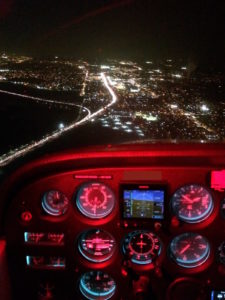 I departed to the east, heading for the Brackett airport (KPOC). It was a smooth and uneventful flight. Flying at night in L.A. is a visual pleasure. Navigation tends to be easier, since the streets and freeways are all lit up. You can see other planes more easily, too, with their lights. Inside the cockpit, we use a red light to illuminate the instruments (which are also backlit) to maintain night vision. I was also wearing a headlamp as a backup. I like my headlamp, but it keeps giving me a headache. I think I need to upgrade to one for people with large heads. :)
I departed to the east, heading for the Brackett airport (KPOC). It was a smooth and uneventful flight. Flying at night in L.A. is a visual pleasure. Navigation tends to be easier, since the streets and freeways are all lit up. You can see other planes more easily, too, with their lights. Inside the cockpit, we use a red light to illuminate the instruments (which are also backlit) to maintain night vision. I was also wearing a headlamp as a backup. I like my headlamp, but it keeps giving me a headache. I think I need to upgrade to one for people with large heads. :)
At Brackett, I did several landings and takeoffs for practice. I mostly had the place to myself except for a pilot who came in and landed to get fuel. It was nice getting to focus more attention on just flying, and the controller was very friendly and accommodating (he was probably glad to have someone to interact with).
On my return to El Monte, a strange thing happened.
7:54 p.m., Me: “El Monte tower, Skyhawk 54678, 7 miles NE of the field at 2200′, inbound for landing with Juliet.”
[no response]7:55, Me: “El Monte tower, Skyhawk 54678, 7 miles NE of the field, 2200′, inbound for landing with Juliet.”
[no response]
El Monte is a class D airport, which means you cannot enter their airspace unless they acknowledge you with a response that includes your callsign. While waiting for a response, I got this:
7:55, Tower: “Attention all aircraft. El Monte class D services will be terminating in 5 minutes.”
The El Monte tower closes at 8 p.m. At that time, the airport converts from class D (with tower services) to class G (without). When it is class G, you can enter without anyone’s acknowledgment (just by announcing yourself). But it was still 7:55, so still class D.
Me (confused, thinking maybe they mean it’s already class G since they aren’t answering me?): “El Monte traffic, this is 678, 6 miles NE of the field, north of the 210, inbound, will make a left base for 19.”
7:56, Me (realizing it must still be class D, so I can’t just enter without acknowledgment): “El Monte tower, if you’re still there, I think I do still need your approval for the next 4 minutes to enter your airspace. This is 678.”
[no response]
At this point, to avoid entering their airspace, I turned my descent into a climb and started circling outside.
7:58, Me: “El Monte tower, Skyhawk 54678, remaining clear of your airspace for 2 more minutes, just to be safe.”
[no response]7:59, Tower: “Attention all aircraft. El Monte tower is terminating class D services. Class G airspace and noise abatement procedures are in effect. The frequency for pilot-operated lights, CTAF, and SoCal approach is 121.2 [etc.]”
8:00, Me: “El Monte traffic, Skyhawk 54678, 7 miles NE of the field, 2100′, inbound for left base for 19.”
I came in and landed. No one else was around. It was a very strange experience.
I think I made a fine decision by staying legal and remaining outside until 8 p.m. I discussed it with my instructor later and he identified some other things I could have tried:
- Try switching to my #2 radio in case I was able to receive but not transmit, and that’s why they weren’t answering me. This is unlikely, since I had just been talking to the Brackett controller, but it would be a good troubleshooting step.
- Try calling the El Monte ground frequency and see if they would answer there.
- Switch to Brackett’s frequency and test my radio again with them. They could probably even call El Monte using a land line and wake them up. :)
- Enter the airspace, assuming that I had a radio problem, and look for light signals (standard procedure if your radio fails). I don’t like this strategy, and if they still didn’t see me or respond (with the light gun), I would end up in a weird state where until 8 p.m. I wasn’t legally cleared into their airspace, but when the clock chimed 8 I could proceed as if it were untowered. This would probably have happened right about when I was on final approach. So probably I could have landed legally. But… ugh.
Ultimately, it comes down to just 5 minutes of time (7:55 to 8:00 p.m.), which seems pretty trivial. But that was the five-minute window in which I found myself, and I had to make a decision about how to proceed. Flying is full of moments like this! It wasn’t an emergency; I wasn’t in danger, and I wasn’t scared, just perplexed. I knew that if I didn’t feel comfortable or wasn’t able to land at El Monte, I could go right back to Brackett and land there. Circling not only helped me stay outside of El Monte’s airspace, but it also gave me time to think about the situation and how best to proceed.
Later I pulled up the ATC recording to see if possibly my radio had suddenly failed and that’s why they didn’t respond. Nope. You can hear all of my queries go unanswered. I typed the exchange above directly from the recording.
Well, if it ever happens again, I now have a good list of backup strategies to try!
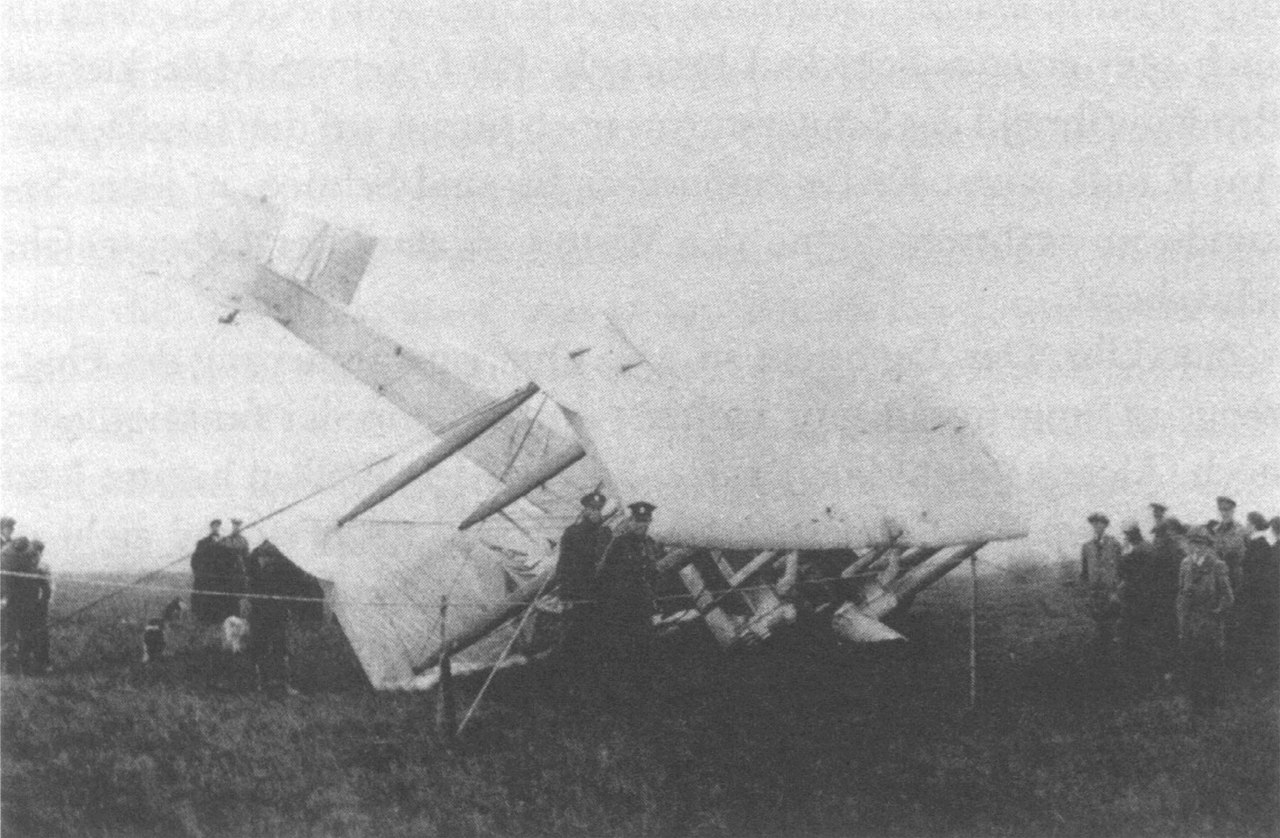
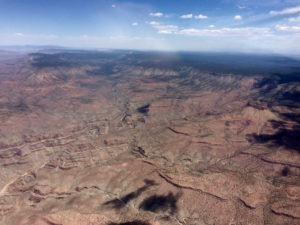
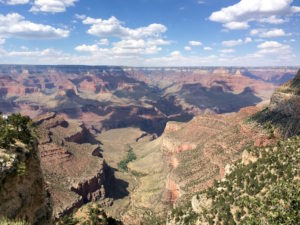
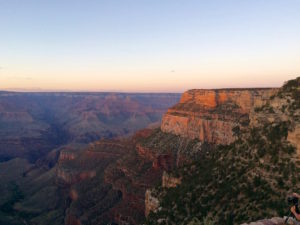
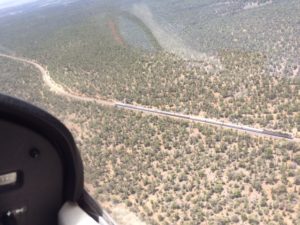
 The winds were a little odd when we arrived – crosswind and gusty, and mildly favoring runway 8, which points into a forested area, as opposed to runway 26, which points into a lake (which therefore poses fewer obstacles). See image at right for what it looks like approaching runway 8 (image credit
The winds were a little odd when we arrived – crosswind and gusty, and mildly favoring runway 8, which points into a forested area, as opposed to runway 26, which points into a lake (which therefore poses fewer obstacles). See image at right for what it looks like approaching runway 8 (image credit